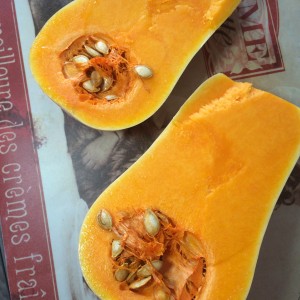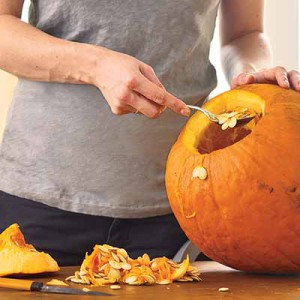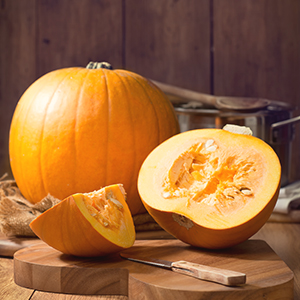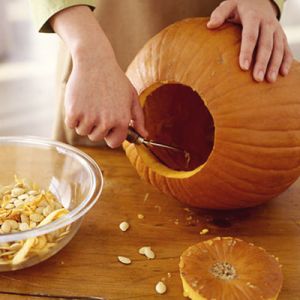Step-by-step instructions on how to peel a pumpkin: an algorithm of actions and life hacks for softening a tough peel
Pumpkin - a nutritious vegetable containing fiber, pectin, vitamins and minerals necessary for the body. Delicious and varied dishes are obtained from it. Before cooking them, the pumpkin is peeled, sometimes tough and dense. To make cleaning easier and save time, there are some small tricks, which we will discuss in the article.
The content of the article
Pumpkin cleaning procedure
The amount of time it takes to peel a vegetable depends on the size, shape of the fruit and the thickness of the skin. For beginners, this procedure often seems too time-consuming, requiring certain skills and physical effort.
But housewives with experience cope with this easily and quickly. Before using the pumpkin for culinary purposes, do the following:
- Surface treatment. The vegetable is cleaned of soil and leaves. Rinse thoroughly under running water. It is undesirable to soak, since the characteristic taste is lost, and in some species the peel is greatly softened and the pulp is damaged during cleaning. A kitchen sink or basin is suitable for washing small pumpkins. Sometimes the fruit grows so large that you have to use the bath and shower. After cleaning from dirt and dust, the vegetable is dried with paper or cloth napkins.

- Peeling. Depending on the future of the dish, the skins are removed or left. If the vegetable is intended for baking in slices in the oven, becomes a component of the juice, or is chopped on a grater, then the peel is not removed. For cleaning, take a wide long knife, cut off the top and bottom 2 cm wide.This will give the fruit stability during further processing, if you place it vertically. Using a saw-knife, carefully so as not to get hurt, peel off the skin in small pieces with planing movements. Instead of a knife, a regular vegetable peeler is also used. If the pumpkin is large or inconvenient in shape, it is cut in half and processed in a horizontal position.
- Seed release. Using a tablespoon, preferably a wooden one, seeds with fibrous pulp are removed from the halves and set aside. Manual cleaning is more efficient. If a whole pumpkin is needed, the top is cut off and the contents are carefully removed with a spoon on a long handle. Seeds are selected from the pulp, washed and dried, spreading on a flat surface in a thin layer.
- Scrubbing the pulp... In a pear-shaped pumpkin, the seed chamber is small, located in the lower part. In order to better process and cut the fruit, it is cut across. In the case of a flattened segmented pumpkin, divided into half-moon parts, the fibers with seeds are removed from each piece separately. A knife is taken with a short or long blade to cut off the remaining fibers in one motion. The pulp is also removed from the peel using the same method.
Fibers with sunflower seeds do not leave in the cut pumpkin, otherwise after 2-3 days it will start to rot.
How to peel thin-skinned pumpkin
Before starting work, carefully examine the surface of the pumpkin and determine its freshness by pressing on the peel. If there is no dent left, the vegetable is fresh and easy to peel.
First, prepare the cutting tool and separate utensils for the pulp, peel and seeds. If there are small decay points on the skin, they are cut out, otherwise pathogenic microorganisms will end up on the pulp.
Well washed and dried pumpkin placed on a wooden board, cut off the top and bottom with a large knife, cut the vegetable in half (lengthwise or across, depending on varieties). The core is removed with a spoon. Set the half vertically on the board, if the fruit is pear-shaped, and proceed to cleaning.
The peel of fresh pumpkin can be easily removed with a knife or a vegetable peeler. Holding the fruit with the free hand, the rind is cut from top to bottom. Already peeled vegetable is divided into pieces of the desired size.
How to peel tough peels
If you take a pumpkin that was kept for a long time, you will have to work hard on it: the peel of the vegetable becomes denser and tougher over time.
In this case, before cutting the skin, for convenience, the fruit is not cut into halves, but into quarters or even separate segments, focusing on which pieces are more convenient to work with. Take a sharp knife and gently shave off the coarse shell in small pieces.
Little tricks
Hard-baked or long-stored pumpkins often resemble tree bark, which makes cleaning difficult. At the same time, hard vegetables with aromatic pulp and tasty sunflower seeds easily processed after heat exposure.
How to peel the skin using the oven
Tough woody skin is softened with a short heat treatment... For this, a clean and dry vegetable (weighing no more than 1-2 kg) is placed in the oven on a baking sheet covered with foil and kept for 10 minutes. Before laying, be sure to make shallow cuts on the peel.
Larger fruits are heated for 15–20 minutes to soften the skin better. If the pumpkin is so large that it does not fit in the oven, cut it in two and heat them separately. The temperature for vegetables of all sizes is 200 ° C.
Important! The main thing is not to overexpose the pumpkin in the oven, otherwise it will bake.
After heat treatment, the casing is easily peeled off with a thin layer without pulp. This method is not only easy but also economical.
Using the microwave
To soften the hard skin, the pumpkin is placed in the microwave. Too large fruit is cut in half and seeds removed.
Previously, the vegetable is pierced several times with a narrow knife, placed in a microwave oven at the maximum temperature, and left for two minutes. Then they take out and cut off the softened skin.
Reference. For fruits with a thin shell and juicy varieties, one minute is enough for the skin to become pliable.
The only drawback of this method is that it is difficult to hold a hot vegetable with your hands. In this case, the fruit is pierced with a fork and held during processing.
Further application
After heat treatment, the pieces remaining after cooking are well stored in the refrigerator, but not more than a week:
- The vegetable is cut into cubes, laid out in portions in plastic bags, placed in the freezer. When frozen, the shelf life is increased to one year. The taste of such a pumpkin practically does not differ from fresh.
- To make cooking easier, the leftovers are chopped to a puree and stored in the freezer. As needed, the product is taken out and added to cereals, soups and other dishes.
- If the vegetable is planned to be used as a basis for fresh juice, a small amount of lemon juice is squeezed onto the pulp. At the same time, the beneficial properties of such a product are preserved for only 2-3 days at a temperature of 0 ... + 4 ° C.
Pumpkin dessert will be tastier if you add a little honey instead of sugar. Pleasant aroma and taste will go well with soft and juicy pulp.
Storage rules
Pumpkins of almost all varieties are stored until spring in the basement, at a temperature of + 12 ... + 15 ° C. They are placed on shelves, straw bedding.
In a city apartment there are 2 storage options: on a glazed balcony or loggia and just on the floor. In the first case, the pumpkin is suitable for consumption for 5-6 months at a temperature not lower than + 2 ° C and an air humidity not higher than 75–80%. At the same time, the following conditions are met:
- the fruits are covered with an air-permeable opaque material to exclude sunlight;
- pumpkins are not laid on a cement floor, linoleum, plastic (boards, plywood, thick fabric are more suitable);
- with the onset of severe frosts, vegetables are wrapped in a blanket or other insulation.
When stored on the floor, vegetables are isolated from each other, sheltered from sunlight. So they will not lose their qualities almost until summer, if the skin has not been damaged.
Important! With high humidity, the pumpkin will quickly rot.
The peeled pumpkin is kept in the refrigerator for no more than two weeks, after having greased the slices with sunflower oil and wrapping the vegetable in cling film. The product can be stored in the freezer for up to 12 months.
How to peel a pumpkin for Halloween crafts
The pumpkin for the lantern is chosen without flaws, fresh. The peel of such a fruit has not yet had time to harden, which means that the patterns will be easier to cut. The shape and size do not matter.
Manufacturing technique:
- A circle or square is drawn around the handle for the future hole.
- With a sharp long knife, cut out the intended "hat" at a slight angle so that when closing it does not fall through.
- With a spoon with a long handle or hand, the fruit is thoroughly cleaned of seeds and fibers. The part on which the face will be depicted is being worked out more carefully from the inside. Take out the pulp in this area until the wall thickness is 2 cm.
- With a marker, they draw holes for the eyes, nose and mouth, frozen in an ominous smile. It is better to make the features larger so that they are more expressive and easier to cut out.
- A knife with a short and thin blade, carefully, so as not to spoil the future lantern, is drawn along the contour of the drawing, gradually deepening into the pulp. The cut pieces are pushed into the pumpkin or pulled out.
- The inner surface is treated with varnish. Even the one used for hair styling will do. This will prevent the fruit from rotting.
- A candle is fixed in the cavity, it is lit with the onset of darkness, the hole is covered with a cut out “cap”.
The result is a Jack Lantern that will become the main attribute of All Saints Day.
Conclusion
Peeling a pumpkin from the skin is a simple process, but sometimes it can be quite laborious and requiring considerable physical effort. Fruits come in all shapes and sizes with a thin, soft skin and tough like the bark of a tree. But after heat treatment in the oven or microwave, the skin is easily removed.
Use our tips and you will succeed!